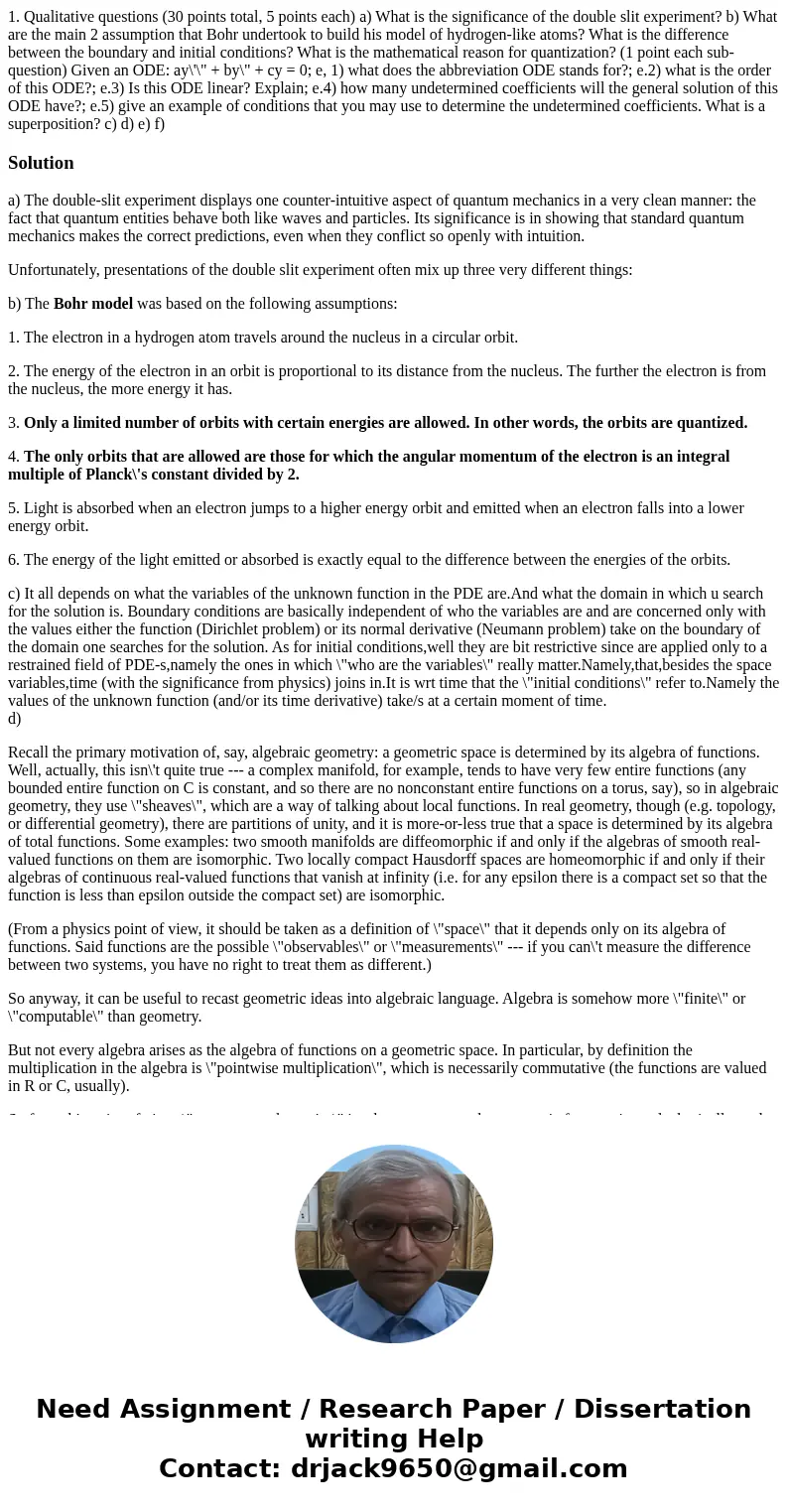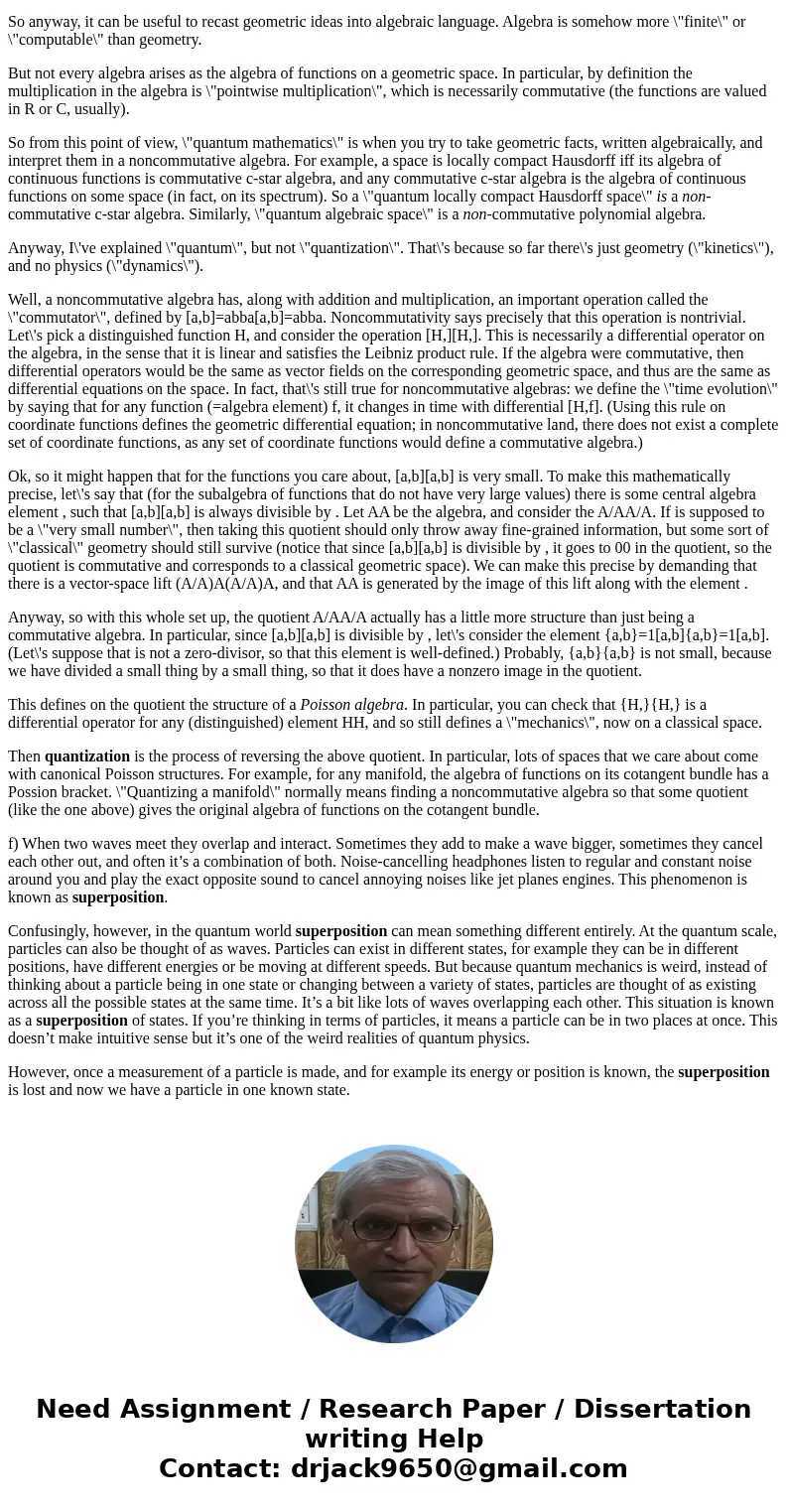1 Qualitative questions 30 points total 5 points each a What
Solution
a) The double-slit experiment displays one counter-intuitive aspect of quantum mechanics in a very clean manner: the fact that quantum entities behave both like waves and particles. Its significance is in showing that standard quantum mechanics makes the correct predictions, even when they conflict so openly with intuition.
Unfortunately, presentations of the double slit experiment often mix up three very different things:
b) The Bohr model was based on the following assumptions:
1. The electron in a hydrogen atom travels around the nucleus in a circular orbit.
2. The energy of the electron in an orbit is proportional to its distance from the nucleus. The further the electron is from the nucleus, the more energy it has.
3. Only a limited number of orbits with certain energies are allowed. In other words, the orbits are quantized.
4. The only orbits that are allowed are those for which the angular momentum of the electron is an integral multiple of Planck\'s constant divided by 2.
5. Light is absorbed when an electron jumps to a higher energy orbit and emitted when an electron falls into a lower energy orbit.
6. The energy of the light emitted or absorbed is exactly equal to the difference between the energies of the orbits.
c) It all depends on what the variables of the unknown function in the PDE are.And what the domain in which u search for the solution is. Boundary conditions are basically independent of who the variables are and are concerned only with the values either the function (Dirichlet problem) or its normal derivative (Neumann problem) take on the boundary of the domain one searches for the solution. As for initial conditions,well they are bit restrictive since are applied only to a restrained field of PDE-s,namely the ones in which \"who are the variables\" really matter.Namely,that,besides the space variables,time (with the significance from physics) joins in.It is wrt time that the \"initial conditions\" refer to.Namely the values of the unknown function (and/or its time derivative) take/s at a certain moment of time.
d)
Recall the primary motivation of, say, algebraic geometry: a geometric space is determined by its algebra of functions. Well, actually, this isn\'t quite true --- a complex manifold, for example, tends to have very few entire functions (any bounded entire function on C is constant, and so there are no nonconstant entire functions on a torus, say), so in algebraic geometry, they use \"sheaves\", which are a way of talking about local functions. In real geometry, though (e.g. topology, or differential geometry), there are partitions of unity, and it is more-or-less true that a space is determined by its algebra of total functions. Some examples: two smooth manifolds are diffeomorphic if and only if the algebras of smooth real-valued functions on them are isomorphic. Two locally compact Hausdorff spaces are homeomorphic if and only if their algebras of continuous real-valued functions that vanish at infinity (i.e. for any epsilon there is a compact set so that the function is less than epsilon outside the compact set) are isomorphic.
(From a physics point of view, it should be taken as a definition of \"space\" that it depends only on its algebra of functions. Said functions are the possible \"observables\" or \"measurements\" --- if you can\'t measure the difference between two systems, you have no right to treat them as different.)
So anyway, it can be useful to recast geometric ideas into algebraic language. Algebra is somehow more \"finite\" or \"computable\" than geometry.
But not every algebra arises as the algebra of functions on a geometric space. In particular, by definition the multiplication in the algebra is \"pointwise multiplication\", which is necessarily commutative (the functions are valued in R or C, usually).
So from this point of view, \"quantum mathematics\" is when you try to take geometric facts, written algebraically, and interpret them in a noncommutative algebra. For example, a space is locally compact Hausdorff iff its algebra of continuous functions is commutative c-star algebra, and any commutative c-star algebra is the algebra of continuous functions on some space (in fact, on its spectrum). So a \"quantum locally compact Hausdorff space\" is a non-commutative c-star algebra. Similarly, \"quantum algebraic space\" is a non-commutative polynomial algebra.
Anyway, I\'ve explained \"quantum\", but not \"quantization\". That\'s because so far there\'s just geometry (\"kinetics\"), and no physics (\"dynamics\").
Well, a noncommutative algebra has, along with addition and multiplication, an important operation called the \"commutator\", defined by [a,b]=abba[a,b]=abba. Noncommutativity says precisely that this operation is nontrivial. Let\'s pick a distinguished function H, and consider the operation [H,][H,]. This is necessarily a differential operator on the algebra, in the sense that it is linear and satisfies the Leibniz product rule. If the algebra were commutative, then differential operators would be the same as vector fields on the corresponding geometric space, and thus are the same as differential equations on the space. In fact, that\'s still true for noncommutative algebras: we define the \"time evolution\" by saying that for any function (=algebra element) f, it changes in time with differential [H,f]. (Using this rule on coordinate functions defines the geometric differential equation; in noncommutative land, there does not exist a complete set of coordinate functions, as any set of coordinate functions would define a commutative algebra.)
Ok, so it might happen that for the functions you care about, [a,b][a,b] is very small. To make this mathematically precise, let\'s say that (for the subalgebra of functions that do not have very large values) there is some central algebra element , such that [a,b][a,b] is always divisible by . Let AA be the algebra, and consider the A/AA/A. If is supposed to be a \"very small number\", then taking this quotient should only throw away fine-grained information, but some sort of \"classical\" geometry should still survive (notice that since [a,b][a,b] is divisible by , it goes to 00 in the quotient, so the quotient is commutative and corresponds to a classical geometric space). We can make this precise by demanding that there is a vector-space lift (A/A)A(A/A)A, and that AA is generated by the image of this lift along with the element .
Anyway, so with this whole set up, the quotient A/AA/A actually has a little more structure than just being a commutative algebra. In particular, since [a,b][a,b] is divisible by , let\'s consider the element {a,b}=1[a,b]{a,b}=1[a,b]. (Let\'s suppose that is not a zero-divisor, so that this element is well-defined.) Probably, {a,b}{a,b} is not small, because we have divided a small thing by a small thing, so that it does have a nonzero image in the quotient.
This defines on the quotient the structure of a Poisson algebra. In particular, you can check that {H,}{H,} is a differential operator for any (distinguished) element HH, and so still defines a \"mechanics\", now on a classical space.
Then quantization is the process of reversing the above quotient. In particular, lots of spaces that we care about come with canonical Poisson structures. For example, for any manifold, the algebra of functions on its cotangent bundle has a Possion bracket. \"Quantizing a manifold\" normally means finding a noncommutative algebra so that some quotient (like the one above) gives the original algebra of functions on the cotangent bundle.
f) When two waves meet they overlap and interact. Sometimes they add to make a wave bigger, sometimes they cancel each other out, and often it’s a combination of both. Noise-cancelling headphones listen to regular and constant noise around you and play the exact opposite sound to cancel annoying noises like jet planes engines. This phenomenon is known as superposition.
Confusingly, however, in the quantum world superposition can mean something different entirely. At the quantum scale, particles can also be thought of as waves. Particles can exist in different states, for example they can be in different positions, have different energies or be moving at different speeds. But because quantum mechanics is weird, instead of thinking about a particle being in one state or changing between a variety of states, particles are thought of as existing across all the possible states at the same time. It’s a bit like lots of waves overlapping each other. This situation is known as a superposition of states. If you’re thinking in terms of particles, it means a particle can be in two places at once. This doesn’t make intuitive sense but it’s one of the weird realities of quantum physics.
However, once a measurement of a particle is made, and for example its energy or position is known, the superposition is lost and now we have a particle in one known state.


 Homework Sourse
Homework Sourse